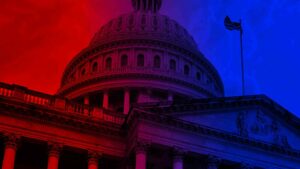DATA POINTS
- 10: The number of days until the Iowa caucuses
- 20 Years Old: The age Facebook will be this year
- 25: The number of states raising their minimum wage this year
- 34: The number of U.S Senate seats up for election this year
- 48%: The number of people who reported improving fitness as their new year’s resolution
- 366: The number of days in 2024
 2024 Tapping the Keg for the Political Party
2024 Tapping the Keg for the Political Party
The 2024 Presidential Election formally kicks off in 10 days with Iowa’s January 15 caucus – and only three Republican candidates have qualified for the same-state CNN debate five days prior. Former President Donald Trump, former South Carolina Governor Nikki Haley, and Florida Governor Ron DeSantis are the only hopefuls invited to attend based on polling qualifications. Haley and DeSantis both confirmed they will participate, while Trump will keep with his streak of avoiding joint candidate appearances and instead participate in a Fox News town hall in Iowa on the same night.
Nationally, GOP polling shows strong support for President Trump and indicates he has persuaded many of those who previously supported Ron DeSantis. At this time last year, Trump had 45% support versus DeSantis’ 34%. Today, those numbers have shifted to 62% and 11.5%, respectively. In the last year, Haley has gained support over the same 365 days, moving from 2.6% to 10.9% year-over-year. The gaps are narrower in Iowa and New Hampshire, but Trump still holds a commanding lead.
Other candidates still maintain lingering support. Ramaswamy is polling at 4.8%, Christie at 3.8%, and Hutchinson sits at a slim 0.6%. Things are looking less hopeful for the hopefuls. New Hampshire Governor Sununu even said “Chris Christie is a friend. But his race is at an absolute dead end.” Tough words to hear as Christie staked his campaign on his performance in the Granite State.
It’s happening ladies and gentlemen: 2024 is here.
Happy Holidays for Retailers
Retailers got exactly what they wanted for Christmas: increased holiday spending. Year-over-year, consumers spent 3% more during the 2023 holiday season. The increase was expectedly modest, amid rising inflation, higher rates of credit card debt, and student loan payments restarting. This year, consumers purchased more clothing, apparel, and food (especially restaurants who saw a 7.8% increase) while they stayed away from jewelry and electronics.
The job market has remained strong, and unemployment has stayed low despite record inflation. As the Federal Reserve keeps raising interest rates to fight inflation, consumers are keeping resilient for now – but that may turn in 2024 as credit card debt is through the roof. Total credit debt equaled more than $1 trillion for the first time in history and delinquency rates are on the up and up, especially on auto and student loans. Skyrocketing mortgage rates over the past two years have reduced home sales – leading fewer people to buy home furnishings, furniture, and electronics.
Balancing growth while controlling inflation is a game of tug-of-war where American consumers can feel more like the rope than the puller. In the meantime, however, most have cash on hand to keep their households afloat.
Investors Tired of the Anarchy

Investors depend heavily on the Fed for direction. On one hand, higher rates drive down the price of existing bonds issued when rates were low. On the other, the same mechanism pushes up the annualized return on those bonds once the prices stabilize.
Investors, much like the rest of the U.S., are eager to return to stable economic footing.
Read More at The Wall Street Journal
From Childhood Bedroom to Homeowner

It’s a winning strategy for nearly 20% of young adults who choose to live at home to push against soaring rents and a real estate market more suited for millionaires. The trade-off is a temporary lack of independence until they can afford to buy their own home – a goal increasingly slipping through the fingers of the age-group peers. It’s no surprise this is a reality, given exorbitant rent prices. The average rent in the U.S. is $1,500 a month. New York City’s average is $4,300, San Francisco is $2,970, Miami is $2,600, and Washington, D.C. is $2,330. Even in middle America – where prices tend to be lower – rent has soared. In Sioux Falls, South Dakota, the median rent is $1,100 (up 11% from the year prior), and in St. Louis, Missouri, you’ll pay $1,100 for a two-bedroom apartment.
The housing market is even more dreary. There are prohibitive listing prices with a median price of $420,000 with 7%+ interest rates. The record low inventories for starter homes are being bought up by Baby Boomers and private equity firms who can outbid with cash-in-hand.
Congressional Democrats have gone so far as to introduce legislation in the House and Senate seeking to fix the issue by prohibiting hedge funds and private equity from buying single-family homes and forcing them to sell their existing portfolios over a decade. While it’s unclear if this bill would be a satisfactory solution (or even pass), young adults are saving as much as they can in an era of everything costing way too much.
Read More at The Washington Post
2024, In a Nutshell

In North Carolina, Republicans are shooting for a political trifecta as Democratic Governor Roy Cooper’s seat is term limited. Attorney General Josh Stein is expected to be the Democratic pick to be matched up against one of several Republicans competing for the nomination.
Of course, red-leaning swing state Ohio is not going to miss out on its moment in the sun. The state’s ninth district, a Congressional seat long held by Democrat Marcy Kaptur, has several Republicans vying in the primary to take her down. Ohio is also one of a handful of states that will determine which party will control the U.S. Senate. Democrat Sen. Sherrod Brown will rally for reelection in the (increasingly) reddish-purple state. And don’t forget the U.S. House of Representatives currently has a 220-213 split between Republicans and Democrats, respectively, which means every seat counts in Congressional elections.
2024 politics are going to be bumpy, so strap yourself in with The Weekender for the biggest updates – every Friday.
From Remote Education to Banning Phones in Class

While proponents say bans are a long-due move to promote students’ education and social well-being, some question if they decrease students’ safety and whether they can be reasonably enforced. Opponents also underscore the ubiquity of cell phones, which are used to communicate pick-ups with parents, act as calculators, listen to music to increase focus, or talk with therapists in real-time. Then, there is the rare but ever-looming threat of school shootings, during which students’ main safety net is using a cell phone to call the police and loved ones.
The bans have been a mainstay across the U.S. and abroad for years. 90% of U.S school districts banned cellphones during the 2009-10 school year, but that number fell to 65% by 2015. England, Finland, France, and the Netherlands have all implemented similar restrictions for students, too. While cell phone bans are effective in supporting students’ education, new problems facing students in an increasingly technologically connected world are sure to be just around the corner.
INTERNATIONAL SPOTLIGHT
One-Child China Reaps What It’s Sown
China’s birth rate is plummeting. Only 10 million babies were born in 2022 compared to 16 million in 2012. If the country cannot convince its people to have more children, it faces demographic collapse to the tune of hundreds of millions. Its current population sits at 1.4 billion. If procreation trends do not reverse, the population is likely to drop to just 500 million by 2100.
Young women in China are resistant to the Communist Party’s demands for more babies, especially given economic and physical well-being concerns. Chinese women feel pressure from authorities and families alike to become child-rearing housewives. High unemployment and a weak job market add uncertainty to raising more children, which is an already costly endeavor for mothers.
The problem is largely the result of China’s “One Child Policy” established in 1980 to curb the country’s extreme population growth. The policy, which was abolished in 2015, enabled authorities to pressure women into having abortions or receiving contraceptive care involuntarily if they became pregnant after their firstborn. Once the policy was revoked, the Chinese government fully anticipated a baby boom in 2016, but instead got a baby bust. In a matter of months and years, the Chinese government went from punishing the same women for having children to urging them to have more.
Read More at The Wall Street Journal
See you next week!
Be sure to follow us on Facebook, Twitter, and LinkedIn for more news and industry updates. To receive a copy of The Weekender in your inbox, sign up here.




 2024 Tapping the Keg for the Political Party
2024 Tapping the Keg for the Political Party


